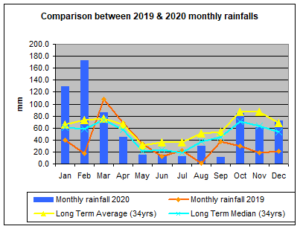Monthly Rainfall Report for Makhanda by ROGER ROWSWELL
December 2020
The rainfall received for December 2020 didn’t disappoint.
In 19 raindays, 72.1mm was recorded at Darling Street. This is slightly above the LTA and LTMed of 68.9mm and 55.5mm respectively.
These welcome rains must have given some relief to the Howison’s Dam water levels – although none of the deluges we require occurred: the highest rainfall occurring in a 24-hour period was 16.0mm (it is understood that the dam catchment received notably higher rainfall), persistent rain over ten consecutive days at the beginning of the month must have brought some relief to water levels. Additionally, 19 raindays in December is a new record for the month. The Ocean Nina Index (ONI) for Sep/Oct/Nov has declined to -1.2.

Looking at 2020 as a whole, the rainfall has been significantly better than 2019: 731.6mm in 2020 vs. 411.3mm in 2021.
January and February were double their respective LTAs and March just above the LTA.
The best daily rainfalls recorded in 2020 were 42.0mm (January), 34mm (February) and 37mm (March). Following this we experienced a very dry period from April through to September, with only 126.9mm.
Three other years experienced similar dry periods: 1992 (163.3mm), 2016 (194.0mm) and 2019 (175.5mm).
The norm for these 6 months is about 273mm; however it bounced back in the last three months to give us a respectable year’s rainfall close to the long term yearly average of 723.4mm.
What was missing in 2020, especially the latter half, was the occurrence of good thunderstorm activity and the accompanying heavy showers.
What is going to happen in 2021?
From the historical data it appears that the drought and flood cycles are of 99 year intervals as opposed to 100 years. This means that the next big flood could happen in 2021. I will therefore do a comparison of rainfall in 2021 with that of Old Gaol in 1922, when the last big flood occurred.

